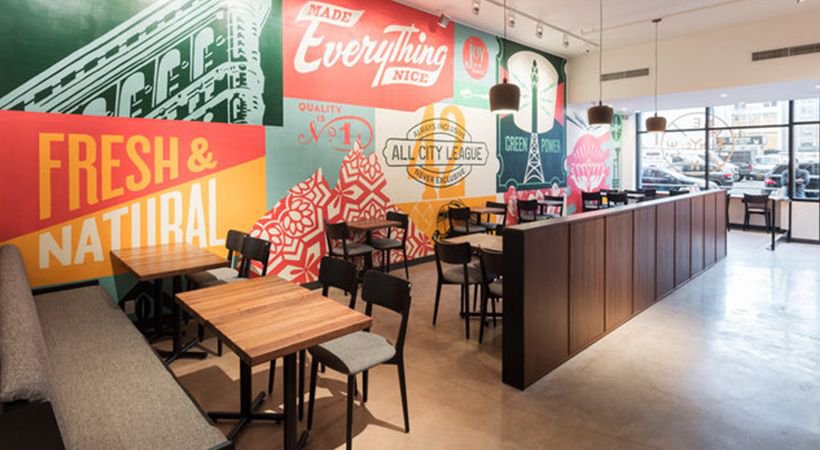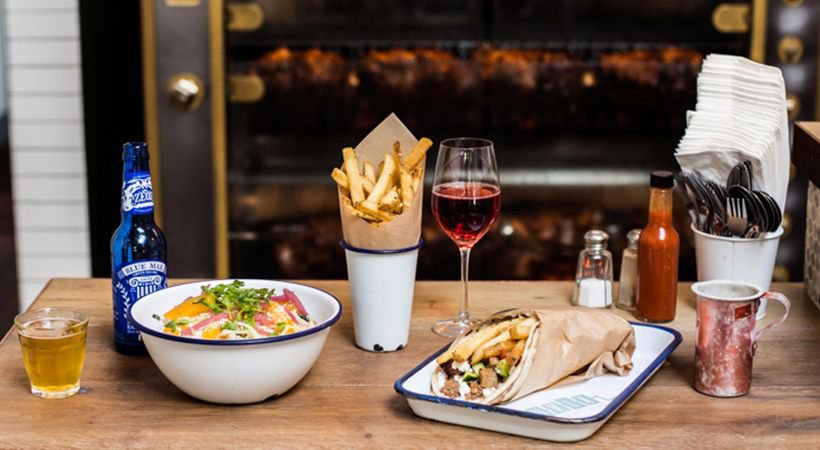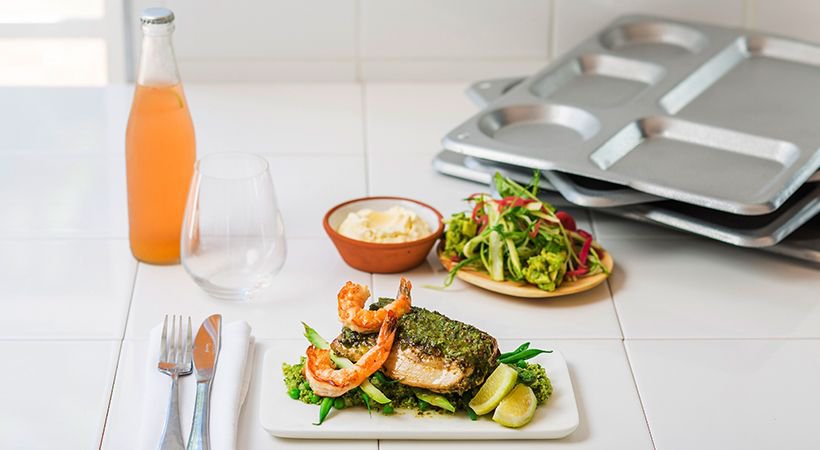Stay abreast of COVID-19 information and developments here
Provided by the South African National Department of Health
Putting the fast
in fine dining
A new type of restaurant seems to be on the rise. ‘Fast-fine’ eateries offer full bars, extensive menus and high-quality dishes – without a waiter in sight.
While the novelty of punching in an iPad order and having a robot assemble your sandwich is already delighting fast-food fans around the world, is it a different kettle of oak-smoked salmon when the waiterless restaurant enters the realm of the fine-dining experience?
It certainly seems so, and this tendency seems to be emerging and expanding along with other restaurant industry disruptors such as the continued blurring of chain restaurant categories and the rise and rise of ‘fine fast food’ — lobster kebabs, foie gras burgers and deer curries, anyone?
But is the death of the waiter greatly exaggerated and is this concept likely to catch on?
The jury of food pundits is still out, despite respected US industry news site foodrepublic.com identifying it as a trend in a recent article titled ‘The Way To Save The Restaurant Industry? Put The Fast In Fine Dining’.
The US is leading the way in this new disruptive dining segment. From hip eateries in San Francisco to New York City, some time-pressed customers are ditching the pomp and ceremony associated with fine dining in favour of affordability, efficiency and control – while still enjoying a superb meal in an elegant setting, with all the touch points of a five-star restaurant.
Trendy San Francisco eateries Corridor, Souvla, Barzotto and RT Rotisserie plus Daniel Hamm and Will Guidara’s Made Nice (the superstar culinarians whose Eleven Madison Park was recently named the ‘World’s Best’ restaurant) are fusing fast casual and fast fine to represent the vanguard of this movement.
This growing number of fast-fine restaurants sees customers placing orders at glossy counters instead of waiting for table staff to do the honours. Runners rather than waiters deliver your meal and when it’s time for a second bottle of wine or a dessert order, it means a nip back to the counter.
There are a number of factors driving this. A changing labour model, which seeks to offset the rising cost of human capital (and the often bemoaned issue of problems that come with hiring and retaining staff), and time-poor consumers’ need to exercise more control over their dining experience.
‘We are not eliminating the whole service aspect; we are just mitigating it,’ RT Rotisserie’s Evan Rich told foodrepublic.com. ‘But we still want to embrace that tone of being taken care of. I see fast fine as a nice restaurant where you just happen to order at the counter.’

New York City’s Made Nice.
As Diana Kelter, an American food services analyst observes, this emerging fast-fine concept specifically caters to millennials, a generation that’s carved out dining preferences drastically different from their older counterparts.
‘Millennials place increased value on experiences, postponing large purchases until later in life in favour of smaller indulgences, such as dining out more frequently.
‘Fast fine offers consumers what they value from fine dining, just at a more affordable, “any occasion” price point,’ she says.
This tendency may just be starting to emerge in the world’s restaurant capitals but how discernible is it in South Africa – and can this model have traction in the emerging market context where every job is sacred?

San Francisco’s Souvla.
For now, Cape Town’s relatively new eatery Chefs, on the corner of a busy street in Gardens, is the first of its kind to reflect this shifting model.
At Chefs, you browse the three daily dishes (such as crispy, grilled prawns with a Vietnamese-style lime, soy, coriander and mint dressing served with a crisp vegetable slaw) on one of the in-house iPads. Orders are then placed via touch screens and paid for upfront, and once you’ve chosen a spot at one of the buzzy communal tables, your meal is delivered on a stylish, customised food tray.
Afterwards, there’s no waiting for bills, payment or change, which means a swift, efficient dining experience for time-pressed city folk who value excellent food.
As Chefs MD Campbell Stevenson says, the concept is a strong collaborative effort and has been crafted over a number of years. ‘The waiterless model means we hire more chefs, as this is the focus of our business. We’re in effect adding to employment in South Africa, while creating new skills in the industry with our trainee chefs.
‘Our concept [that focuses on good food, chefs and the patron] has been very well received by diners and we’ve no doubt it’ll gain traction in South Africa and globally,’ he says.

Cape Town’s Chefs.
The advantages of a waiterless operation are obvious for the restaurant industry and the consumer, says TASTEmagazine editor Kate Wilson. ‘For the proprietor it means significantly lower overheads. For the customer it means less stress around long waits for service.’
And any awkward conversations between dining companions about tipping fall away when there’s essentially no one to tip. Plus, the bill is significantly lighter on your pocket because of reduced service costs.
‘The existing fine-dining concept is dated and exclusive and frankly, dull,’ Kate adds. ‘It’s out of reach for so many people and those who can afford it would rather eat simpler food that doesn’t take six hours to eat, a magnifying glass and a dictionary. Who can be bothered?’
But those at the helm of exceptional fine-dining establishments disagree. ‘Fine dining is all about being spoiled, it’s about the theatre and ceremony of the table’, says chef Chantel Dartnall of Restaurant Mosaic at The Orient in Pretoria. ‘A fine-dining restaurant should clearly set itself apart from others by providing diners with a level of service and quality that is unforgettable. ‘
Abigail Donnelly, chief judge of the prestigious Mercedes-Benz Eat Out Restaurant Awards, weighs in. ‘Waiterless dining can work in fast-food and more casual eateries where the diner needs no interaction between the menu and the chef. But fine dining isn’t just about the food. The chef’s investment requires waitrons to explain and entertain, giving the diner a bespoke experience.’
Celebrity chef Peter Goffe-Wood agrees, adding that in the top-end restaurants, waiters do add value to the dining experience. ‘The waiterless concept may have traction in a more tech-savvy environment but most fine-dining establishments are still frequented by an older demographic who’d rather be served.’
Fine dining interrupted or not, it seems waiters are still a fair way away from being served their marching orders.
We constantly challenge the norm. Our investment process is a thorough and diligent one.
Michael York has spent 21 years in Investment Management.

Have a question for Michael?
South Africa
South Africa Home Sanlam Investments Sanlam Private Wealth Glacier by Sanlam Sanlam BlueStarRest of Africa
Sanlam Namibia Sanlam Mozambique Sanlam Tanzania Sanlam Uganda Sanlam Swaziland Sanlam Kenya Sanlam Zambia Sanlam Private Wealth MauritiusGlobal
Global Investment SolutionsCopyright 2019 | All Rights Reserved by Sanlam Private Wealth | Terms of Use | Privacy Policy | Financial Advisory and Intermediary Services Act (FAIS) | Principles and Practices of Financial Management (PPFM). | Promotion of Access to Information Act (PAIA) | Conflicts of Interest Policy | Privacy Statement
Sanlam Private Wealth (Pty) Ltd, registration number 2000/023234/07, is a licensed Financial Services Provider (FSP 37473), a registered Credit Provider (NCRCP1867) and a member of the Johannesburg Stock Exchange (‘SPW’).
MANDATORY DISCLOSURE
All reasonable steps have been taken to ensure that the information on this website is accurate. The information does not constitute financial advice as contemplated in terms of FAIS. Professional financial advice should always be sought before making an investment decision.
INVESTMENT PORTFOLIOS
Participation in Sanlam Private Wealth Portfolios is a medium to long-term investment. The value of portfolios is subject to fluctuation and past performance is not a guide to future performance. Calculations are based on a lump sum investment with gross income reinvested on the ex-dividend date. The net of fee calculation assumes a 1.15% annual management charge and total trading costs of 1% (both inclusive of VAT) on the actual portfolio turnover. Actual investment performance will differ based on the fees applicable, the actual investment date and the date of reinvestment of income. A schedule of fees and maximum commissions is available upon request.
COLLECTIVE INVESTMENT SCHEMES
The Sanlam Group is a full member of the Association for Savings and Investment SA. Collective investment schemes are generally medium to long-term investments. Past performance is not a guide to future performance, and the value of investments / units / unit trusts may go down as well as up. A schedule of fees and charges and maximum commissions is available on request from the manager, Sanlam Collective Investments (RF) Pty Ltd, a registered and approved manager in collective investment schemes in securities (‘Manager’).
Collective investments are traded at ruling prices and can engage in borrowing and scrip lending. The manager does not provide any guarantee either with respect to the capital or the return of a portfolio. Collective investments are calculated on a net asset value basis, which is the total market value of all assets in a portfolio including any income accruals and less any deductible expenses such as audit fees, brokerage and service fees. Actual investment performance of a portfolio and an investor will differ depending on the initial fees applicable, the actual investment date, date of reinvestment of income and dividend withholding tax. Forward pricing is used.
The performance of portfolios depend on the underlying assets and variable market factors. Performance is based on NAV to NAV calculations with income reinvestments done on the ex-dividend date. Portfolios may invest in other unit trusts which levy their own fees and may result is a higher fee structure for Sanlam Private Wealth’s portfolios.
All portfolio options presented are approved collective investment schemes in terms of Collective Investment Schemes Control Act, No. 45 of 2002. Funds may from time to time invest in foreign countries and may have risks regarding liquidity, the repatriation of funds, political and macroeconomic situations, foreign exchange, tax, settlement, and the availability of information. The manager may close any portfolio to new investors in order to ensure efficient management according to applicable mandates.
The management of portfolios may be outsourced to financial services providers authorised in terms of FAIS.
TREATING CUSTOMERS FAIRLY (TCF)
As a business, Sanlam Private Wealth is committed to the principles of TCF, practicing a specific business philosophy that is based on client-centricity and treating customers fairly. Clients can be confident that TCF is central to what Sanlam Private Wealth does and can be reassured that Sanlam Private Wealth has a holistic wealth management product offering that is tailored to clients’ needs, and service that is of a professional standard.